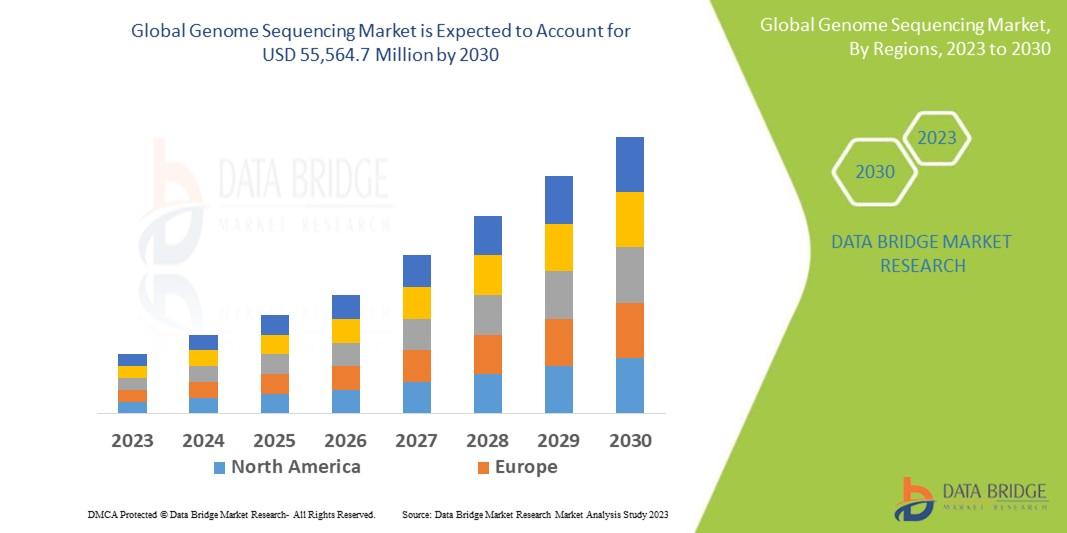
We are living in a time when reading the entire DNA code of any living organism is not only possible—it’s becoming routine. Genome sequencing, once a multi-million-dollar endeavor taking years to complete, has transformed into a scalable, high-speed tool that is revolutionizing medicine, agriculture, biotechnology, and beyond.
The Genome Sequencing Market is witnessing explosive growth as personalized medicine, disease diagnosis, and biological research move to the forefront of innovation. With falling costs, rising accessibility, and continuous breakthroughs in next-generation sequencing (NGS), genome sequencing is set to reshape how we understand and interact with biology.
Get More Details: https://www.databridgemarketresearch.com/reports/global-genome-sequencing-market
What is Genome Sequencing?
Genome sequencing is the process of determining the complete DNA sequence of an organism’s genome. It provides critical insight into genes, mutations, and genetic predispositions.
Types of Genome Sequencing:
- Whole Genome Sequencing (WGS) – Maps the entire genome.
- Whole Exome Sequencing (WES) – Focuses on protein-coding regions of the genome.
- Targeted Sequencing – Analyzes specific regions of interest related to diseases.
Market Overview
The global genome sequencing market was valued at USD 7.8 billion in 2023 and is projected to reach USD 29.5 billion by 2030, growing at a CAGR of 20.1%. This rapid expansion is driven by its increasing use in clinical diagnostics, precision medicine, cancer genomics, and agricultural innovation.
Key Market Drivers
🧬 Personalized Medicine Revolution
Genome sequencing allows doctors to tailor treatments based on an individual’s genetic makeup, especially in oncology, rare diseases, and pharmacogenomics.
🩺 Increased Genetic Disease Detection
Early detection and risk assessment for hereditary cancers, Alzheimer’s, and cardiovascular diseases are now routine in clinical settings.
🔬 Next-Generation Sequencing (NGS) Advancements
NGS offers faster turnaround, high accuracy, and lower costs, making genome sequencing more accessible across industries.
🧠 Government & Private Sector Investments
Massive funding from healthcare agencies, biotech giants, and startups is fueling innovation and infrastructure development.
Applications of Genome Sequencing
🧫 Medical Diagnostics
- Identifies mutations and gene variations in diseases like cancer and rare genetic disorders.
- Supports prenatal screening and newborn testing.
💊 Drug Discovery and Development
- Helps pharmaceutical companies understand drug-gene interactions.
- Reduces clinical trial time through biomarker-driven recruitment.
🌱 Agriculture & Animal Breeding
- Used for crop improvement and disease resistance.
- Enhances livestock productivity and genetic diversity.
🦠 Infectious Disease Surveillance
- Plays a key role in identifying viral mutations (e.g., COVID-19 variants).
- Supports vaccine development and epidemiological tracking.
Market Segmentation
By Product & Service
- Sequencing Instruments & Consumables
- Sequencing Services
- Data Analysis Software
By Technology
- Next-Generation Sequencing (NGS)
- Sanger Sequencing
- Third-Generation Sequencing
By End User
- Hospitals & Clinics
- Research Institutions
- Biopharmaceutical Companies
- Academic Institutes
Regional Insights
- North America dominates due to advanced research infrastructure and major players like Illumina, Thermo Fisher Scientific, and Pacific Biosciences.
- Asia-Pacific is the fastest-growing region, driven by China, India, and Japan investing heavily in genomic research.
- Europe is expanding genome programs such as the UK’s 100,000 Genomes Project and EU-wide precision medicine initiatives.
Challenges in the Genome Sequencing Market
⚠ Data Interpretation Complexity – Converting raw sequences into actionable insights requires sophisticated bioinformatics tools and expertise.
⚠ Ethical & Legal Issues – Concerns over genetic privacy, consent, and data security continue to raise debates.
⚠ High Initial Setup Costs – Despite falling sequencing costs, infrastructure and talent acquisition remain expensive.
⚠ Regulatory Barriers – Varying regulations across countries create hurdles in international genomics collaborations.
Future Outlook
🚀 AI & Machine Learning in Genomics
AI-powered platforms will enhance mutation prediction, risk scoring, and treatment optimization.
🌍 Global Genome Projects
Initiatives like All of Us (USA), GenomeAsia 100K, and Africa Genome Project will generate vast data for global health equity.
🔬 Home-Based & Portable Sequencing Devices
Affordable and accessible DNA testing kits and handheld sequencers are on the rise for point-of-care diagnostics.
🧬 Multi-omics Integration
Combining genomics, proteomics, and metabolomics to offer a holistic understanding of diseases and therapies.
Conclusion
The Genome Sequencing Market stands at the intersection of science, technology, and personalized healthcare. As innovation continues to accelerate, genome sequencing is unlocking new possibilities in early diagnostics, precision treatments, and life science discoveries. The next decade promises a genomic revolution where sequencing one’s DNA may be as routine as a blood test—empowering individuals and transforming entire industries.
FAQs
1. What is the cost of whole genome sequencing today?
The cost has dropped significantly—from over $100 million in 2001 to less than $500–$1,000 in 2024, depending on service and depth.
2. Which companies are leading the genome sequencing market?
Key players include Illumina, Thermo Fisher Scientific, BGI Genomics, Oxford Nanopore Technologies, and PacBio.
3. Is genome sequencing used in cancer treatment?
Yes. It helps in identifying tumor mutations, guiding targeted therapies, and predicting drug resistance in cancer patients.
4. What is next-generation sequencing (NGS)?
NGS is a modern sequencing technology that enables fast, accurate, and large-scale DNA sequencing, revolutionizing genomics research.
5. Is genome sequencing ethical?
While powerful, genome sequencing raises privacy, consent, and data security issues that require ethical frameworks and strict regulations.

